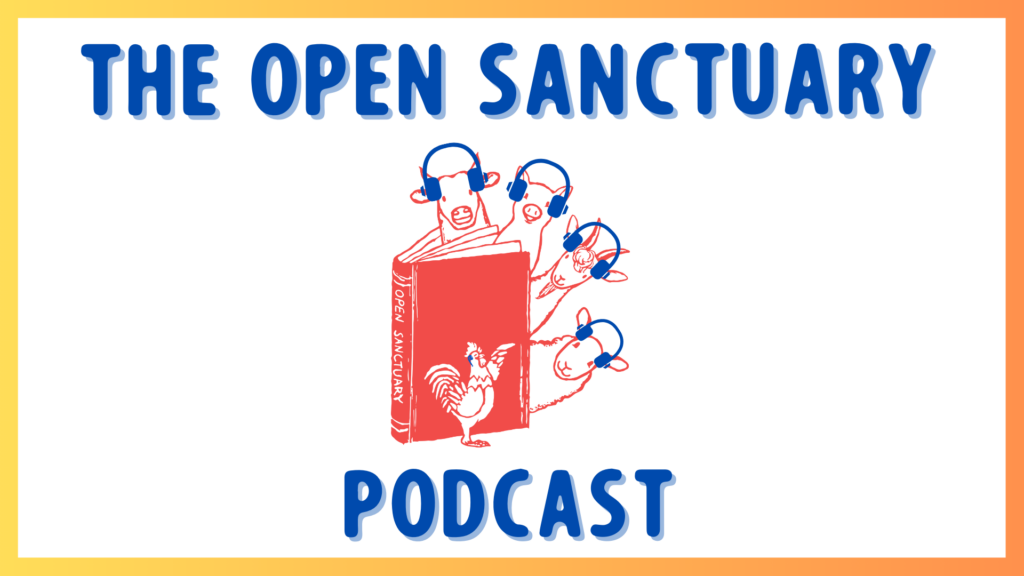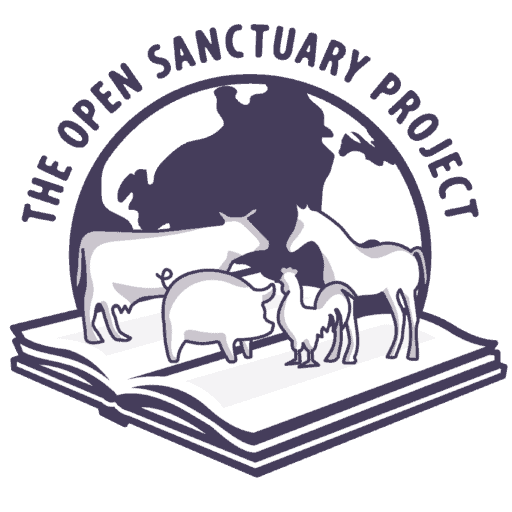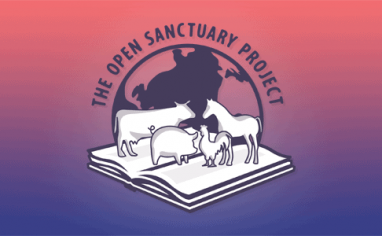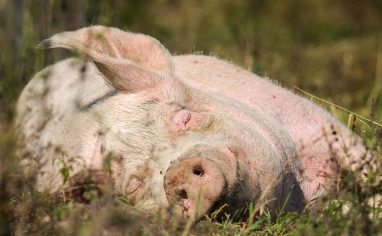
Subscribe To The Open Sanctuary Podcast
If you’d like to get the latest episodes of The Open Sanctuary Podcast, you can subscribe for free on all Podcast platforms, including Apple Podcasts and Spotify!
Episode Notes
At the Open Sanctuary Project, we know that the idea of unpacking animal exploitationExploitation is characterized by the abuse of a position of physical, psychological, emotional, social, or economic vulnerability to obtain agreement from someone (e.g., humans and nonhuman animals) or something (e.g, land and water) that is unable to reasonably refuse an offer or demand. It is also characterized by excessive self gain at the expense of something or someone else’s labor, well-being, and/or existence. with youth might seem like a daunting task. But if we want younger generations to help us imagine and create a world that is free from animal exploitation, it’s essential that we engage them in anti-speciesist thinking and challenge their human-centered behaviors towards animals as early and often as possible. So, how can animal sanctuaries help create safe space for discussing this tough topic with youth in a way that conveys a sense of moral urgency but not a sense of hopelessness? To help sanctuaries feel more confident in their ability to engage with children, Community Education Specialist Andie chats with Senior Advisor Tara and NonprofitA non-governmental organization whose primary purpose is something other than selling goods or services. Specialist Julia in today’s podcast episode about some of the ways sanctuary educators can make discussion around animal exploitation more suitable and meaningful for youth.
—
This Episode’s Referenced Open Sanctuary Project Resources:
- Communicating with Youth About Animal Exploitation
- The Differences Between an Animal Sanctuary and a Petting Zoo
- What to Consider When Children Visit Your Animal Sanctuary
- Fostering Empathy Towards Farmed Animals
- Fostering Critical Thinking at Your Animal Sanctuary
- Understanding Biases that Can Negatively Impact Farmed Animals and How to Help Folks Overcome Them
- A Starter Guide to Common Questions Your Sanctuary Gets Asked and How to Thoughtfully Answer Them
Episode Transcript (Auto-GeneratedThe following content was transcribed through an automated process and may contain transcription errors or misspellings.)
Andie Springirth: Welcome to the Open Sanctuary Projects podcast where we have conversations about all things animal sanctuary related. My name is Andie Springirth. I am the Community Education Specialist at OSP and I am joined today by my friends and colleagues Julia Magnus, our nonprofit specialist, and Tara Hess, our senior adviser. And in today’s episode, we are going to be talking about the sometimes daunting task of communicating with children about animal exploitation at your animal sanctuary and how you can make that a little bit easier on yourself. So Julia and Tara, thank you so much for joining me today. So I want to start off today’s conversation by focusing on a really important aspect of education in general, and in particular for this topic, which is preparation. So, as with all tough conversations and topics, it is really important to be prepared in advance. And one of the ways that we can do this is by doing our research, whether that be academic research, and we are going to get a little bit more into that soon in terms of how cognitive and emotional development impact our conversations and the ways we approach these conversations with kids. But another way that we can prepare in advance for conversations around topics like this is by learning about and from the direct experiences of others who have already had these conversations with kids. I think those experiences are invaluable and they can teach us a lot. So on that note, I would love to invite my friend and colleague Tara, who is a mom herself of an elementary age child, to share a little bit about what that experience has been like navigating tricky conversations around animal exploitation that have probably inevitably come up at some points throughout your child’s life, particularly as the parent of a child who has been veganAn individual that seeks to eliminate the exploitation of and cruelty to nonhuman animals as much as possible, including the abstention from elements of animal exploitation in non-food instances when possible and practicable as well. The term vegan can also be used as an adjective to describe a product, organization, or way of living that seeks to eliminate the exploitation of and cruelty to nonhuman animals as much as possible (e.g., vegan cheese, vegan restaurant, etc.). from birth. So to restate the question more succinctly, what are those conversations like? What have those conversations been like? And how have you responded to them when they have come up and how has your child processed your responses to those types of information about animal exploitation?
Tara Hess: So, like you mentioned, my kiddo has been vegan since birth and she is being raised by two parents who, when she was born, we were both working at a farmed animal sanctuaryAn animal sanctuary that primarily cares for rescued animals that were farmed by humans.. And so, she spent those first few years. We did not live on site, but it is like she might as well have. And she spent so much time there interacting with the residents, seeing me work, hearing some of the conversations that happen among caregivers. My partner is a videographer, so she would sometimes see his work, and not like the super graphic things, but she would see in his work and then also firsthand what a resident sometimes looks like when they arrive and what they look like later on. And we would not necessarily be like, “Look, look how terrible they look,” but she could tell. She could see the difference. And so she has that background and then also working on the sanctuary. We were very much in a bit of a bubble where she was surrounded by other vegansIndividuals who seek to eliminate the exploitation of and cruelty to nonhuman animals as much as possible, including the abstention from elements of animal exploitation in non-food instances when possible and practicable as well., which I know sometimes there is a component of isolationIn medical and health-related circumstances, isolation represents the act or policy of separating an individual with a contagious health condition from other residents in order to prevent the spread of disease. In non-medical circumstances, isolation represents the act of preventing an individual from being near their companions due to forced separation. Forcibly isolating an individual to live alone and apart from their companions can result in boredom, loneliness, anxiety, and distress. that she did not have at that time. So anyways, her sort of normal sense of the world was that these species who lived at the sanctuary, they were just treated well. They were happy. If they were sick, they were cared for. They were respected. That was just her normal view of the world because that is what she saw. And so then when she would go to daycare or start interacting even with family members who are vegan, I feel like the point at which a child who has a different background might be like, “Is this chicken on my, that chicken?” She had like the reverse of that, which was like, “Wait, when grandpa is eating chicken, he is eating these chickens that I feed at the sanctuary and that I love.” And so we would have conversations around that, you know, and I could see how upsetting it was for her to realize that because I think especially when kids get into that age where it is very much right and wrong and fair, it just did not sit well with her. So, we still had conversations around that. I am not sure if I totally answered your question, but one thing that I have seen, which I feel like might be relevant and this happens with other types of conversations too, is sometimes a situation will come up that warrants a conversation, like it sparks a conversation, or she will ask a question and I will answer it and I will think it is going to go somewhere and it does not and she just sort of takes it in. And then it might be like a day later, a week later, a month later. Sometimes she is like, “Remember when you said this thing?” And I am like, “I do not.” But now she is ready to talk about it. And now she has follow-up questions. And so I sometimes try to just lead with that. Like even if I feel like there is more information I want to share, I try to let her sort of steer the conversation. And if she does not have the question, I just sort of wait. And inevitably, she does have the question eventually.
Andie Springirth: That is, I am so, I so appreciate you saying that and I am so glad you brought those points up. I just want to emphasize a couple of the things that you mentioned in terms of how you responded to her. One of those is you brought up the fact just at the end there that you let her lead this conversation. So I want to note for our listeners here that a lot of times I think when we are in these kind of educator and facilitator roles, we feel like we have to lay it all out. Like we just have to let them know everything about this. Like here is A to Z what you need to know about this topic so that you can help us make this change. But in fact with kids especially, but also with adults, but what we are focusing on kids today and this is especially important for young children, especially in terms of being age appropriate, is that you can let them lead. So whether you know the kids or not, let them ask the question, answer honestly and appropriately, and then let them kind of volley back if they want to instead of being like, “Yes, and here is what happens.” See if they are ready for more information. Some of them may volley back right away with another question and you can go based off of that. Some of them might just become very quiet as they start to process this kind of information. So, I really appreciate that, kids, especially elementary aged kids, just being suggestive of what is going on in traditional industrial agricultural settings is enough as well. In fact, that is enough. We do not necessarily need to, we should not be going into graphic detail about anything that is going on at that age and younger, particularly because kids are so impacted, seriously impacted by these kinds of graphic imagery and depictions of what is happening to animals. Research has actually shown that when we utilize too much of that with kids, it has the opposite effect of what we are trying to have on them. So with adults, for example, sometimes showing images of suffering can make an impact on people to make a change, but with adults and especially with kids, overwhelming them with imagery and depictions of suffering can actually lead to inaction, feelings of kind of maybe even digging their heels in a little bit further of where of what they have already been taught. I cannot do anything about that, so that happens with kids too, but especially in terms of imagery it has that impact. So yes, let them lead you through the conversation. I think that is a really important point. With that said, Tara, you also brought up the ideas of fairness and unfairness with your kidA young goat. And I am really glad that you spoke about that because for kids who are in elementary school and younger, these are concepts that they actually can understand and grasp. And so, you want to harness that in your conversations in your sanctuary educational programming. If someone is sitting with you or in your space and they ask you that question that you brought up, “Is this the same animal that is on my plate at dinner time?” You can say, “Yeah, it is.” You know, you want to be honest about it. Like I said, you do not have to go into graphic detail, but you want to say, “Yes, it is.” And then follow up with, “How does that make you feel?” When I learned about this and discovered this, this made me feel really bad. So sharing your own journey, being honest about it, allowing them an opportunity to process it and then, if they feel compelled to share, that is great. Validate those challenging feelings. And even if they do not, you can start to talk about the idea that that is not fair. They understand that concept. It is not fair that this happens to these animals that we are seeing right now, that we are potentially, if appropriate, interacting with right now.
Tara Hess: I was going to say one thing in response to what you were saying, which I do not know if it is helpful or maybe it is just already what you said, but in terms of letting the kid lead the conversation and also fighting that urge is not the right word, but that idea that you have to do A through Z and go through all of it. I feel like those two things really go together because sometimes, and this happens with other big conversations that come up, like the question in of itself is so big where you are sort of like, “Where is this going?” Like if it is something like, “Well what happens to a chicken on a farm?” Obviously depending on who I am talking to, I could go into a really long thing about what is going to probably happen to that chicken. But with kids, or at least with my kid, I try to take a step back and I have learned this by not doing that. Like take a step back and be like, “Well, what do you think happens?” Or, “Well, what exactly do you mean?” to try to get more information because sometimes the question feels like huge and daunting where I am like, “Oh, I did not think we were going to get into this yet.” And then when she talks more, I realize that that was not where she was going at all. You know, sometimes just being like, “Yeah, you are right. They are taken away from their mother,” or, “Yes, they are killed,” but do not have to get into the graphics of what happens at a slaughterhouse.
Andie Springirth: Interesting. Yeah. Absolutely not. Yeah. And nor should you, especially at that age. I really appreciate you bringing that up. Yeah. On that note, so some of you may be wondering when it is appropriate to bring up the more graphic depictions, descriptions, and imagery of animal suffering. And we have a lot more about this in the full resource that we wrote on this topic, which I encourage everybody to take a close look at in terms of the cognitive and emotional development and being able to handle this appropriately. But what we generally know is that by the time kids are in their teenage years and older, this is typically when you can start to introduce more information. Let me put it that way. This is when you can start to show imagery that is not only necessarily suggestive of suffering, which is something that is safe to do with younger kids. So, for younger kids, you could show the environment that a pig in a traditional agricultural setting is forced to live in, but you certainly would not show the slaughter floor. Now, is showing an image of where a pig is slaughtered appropriate for a teenager and a young adult and older? It could be okay. It could be, but this is where you have to be very mindful that every person who is coming into your space is an individual with an individual history. So being mindful that if you are going to, if you are presented with this question or this particular part of this topic, that you respond to it and then like we said earlier, not overwhelm. Regardless of the age of the person, you do not want to overload with this kind of imagery, but you can be honest and you can become more descriptive at this age. Teenagers and young adults and of course older can handle this information now. But you cannot just plop it on them like that. You have to, again, just like with younger children and adults, you have to let them process this, explicitly provide them opportunities to process this. That could be verbally, as we mentioned earlier, asking others, “How does this make you feel?” And again, sharing your own experience with this. That can be really beneficial for folks to say, “Okay, I am in a safe place because this person went through the same exact experience as me.” You could do this as a written exercise. If you are with a group of tweens or teens, you might include some kind of journal entry as part of this particular part of the program where they are encouraged to write about how this makes them feel. It might also be an artistic exercise. There are a lot of folks who prefer to express themselves more visually in this way, and that can be really impactful. But helping them process is really important because unlike most adults, I will not say all adults because not all adults know how to process feelings in a healthy way, but unlike a lot of adults, kids do not have the tools yet to do this and it is our job as adults and as sanctuary educators in this role to help them to help them go through this. I also want to say from a cognitive and emotional perspective, tweens and teens, they are in a unique position because they are starting to experiment with their identities. And what that means is that, I mean, we have all been here. All three of us have been in this position. You are being more heavily influenced by your peers. It is not to say that you are not when you are younger, but your peers are a much heavier influence on you in today’s age. So are social things like social media and the internet. Those play an important role in influence. But adults still have a heavy influence on kids, too. So, in this role as sanctuary educators, when you are with a group of older kids who are in their tweens and teens, it is important to consistently model the behavior and language around animals that you want them to adopt. And doing this during their time and their stay at your sanctuary is providing them not only with a positive alternative to what they are getting out in the more speciesist world outside the sanctuary setting, but it is also helping them build confidence in another identity, an identity that is rooted in empathy and consideration of others, especially animals in this case. So, all of these things just from a developmental perspective and age perspective are important things to be informed about. And like I mentioned just a few minutes ago, there is a lot more information about this development in the full resource on this topic, but I want to touch back on something, Tara, that you brought up with your own kid, which is that moment when your kid asked you or someone who is with your kid in the classroom realized that that animal that they are seeing is who is on their plate. So this, if you are a sanctuary educator out here listening right now and you are, I just want you to imagine that you are in front of a group of kids. You are in front of the chicken coop. Maybe you are even inside of the living spaceThe indoor or outdoor area where an animal resident lives, eats, and rests. of the chickens if this is appropriate and safe. And you are allowing the kids to offer the chickens some treats, some nutritional enrichment. And one of those kids turns to look at you and they are like, “Hey, is this who I am eating?” All right. I am going to go back to this question. Julia, I want to, I am bringing this up because a few days ago you brought up that you may have had this experience during one of your educational pursuits as a micro sanctuary operator and that you were not sure if it was okay to answer that question. I want to offer you some space to talk about what that experience was like, how you did choose to respond.
Julia Magnus: Well, let me back up for a second because you know my background. I have no educational background. I do not know how kids work. I am frankly terrified of them. They are very strange. I do not remember what it was like to be one. I do not think I ever probably was one. I am old as dirt at this point. And this is something that mystifies and startles me constantly when I am trying to do outreachAn activity or campaign to share information with the public or a specific group. Typically used in reference to an organization’s efforts to share their mission. work. So yes, I have a micro sanctuary. We also do rescue work in Chicago. And we have not done this since H EI became a thing, but we did have certain residents or fosters who really enjoyed interacting with humans. And so we would on occasion do outreach bringing those residents along. On those occasions when I see kids coming up, I am like, “Oh no. Oh god. What? What? No. Please not the tiny humans.” Because I do not know. I never know what is okay to say. So, you have actually offered me wildly helpful information in all the stuff that you were just describing like the cognitive development. That resource, rereading it in preparation for this, really helped me out a lot. I still am like, “I need to learn how size coincides to age with children,” because I am not sure, you know, “Are you tall enough to ride this ride at this point?” I do not know, you know, that is really important that you pointed that out, the research, the learning what is appropriate when is so helpful to me, but yes, I have had kids come up and then there have been, so there are two issues that I encounter. One is, “All right, can I touch them? Can I petAn animal who spends regular time with humans in their home and life for companionship or human pleasure. Typically a small subset of animal species are considered to be pets by the general public. them?” Well, you know the answer to that always depends, right, on the state of the person that you are talking about. So if you have somebody with you to do outreach, you have to carefully monitor them and make sure that they are comfortable. And sometimes they are not. And so you have to just be able to say to a kid nicely, which you know, it is hard because they are excited. They want to see. They want to touch. They want to feel. This is maybe the first time they have ever seen a chicken. They also want to know, “Is this what I am eating for dinner?” What I do not even know. It is overwhelming and exhausting to try and figure out how you deal with these things on the fly and that is all I have ever done is deal with it on the fly. So your guidance here is wildly important and helpful. I have usually just deferred to parents. I have kind of given an eye glance up to the parent and be like, “Maybe you should talk to your parents about that.”
Andie Springirth: No, no, that is really helpful. I think your experience is what a lot of folks experience especially in sanctuary settings.
Julia Magnus: You mean my terror? My generalized terror of children?
Andie Springirth: In sanctuary settings and beyond. I mean, in classroom settings, as parents, we have these terrifying moments where you are faced with these kinds of things. And one of the reasons I asked you that, Julia, is because I remember you bringing up the fact that you sometimes defer to parents and this brought up something, a little tip I wanted to offer sanctuary educators. I think it is incredibly important if you are going to facilitate programs with children that you are very clear in advance in your, if you can, in your marketing materials, on your social media channels, etcetera. If you have any kinds of brochures or anything or even if it is just a conversation beforehand where you are inviting someone to do it, that you are clear and explicit about what kind of content is going to be in it. Just like we do with adults, let the parents have the knowledge to decide beforehand if this is something that they want to expose their kids to. I will be fully transparent here. I have been in situations in various settings, rescue and sanctuary settings, where parents were not fully informed about the content, and of course even being, presenting information age appropriate and developmentally appropriate way, I could still see on their chaperone or parent or caregiver’s face that kind of shock, like, “Oh, we are going there right now.” And sometimes this is also because a lot of people who bring children and families into sanctuary settings, they come in with this expectation that it is going to be more akin to a petting zooAn organization where animals, either rescued, bought, borrowed, or bred, are kept, typically for the benefit of human visitor interest. experience and we can go off on a whole tangent about that. Again, another reason why it is so important to be very clear and explicit beforehand about what kind of content is going to be presented and then that empowers you, folks like you Julia and other sanctuary educators, if someone is like, “Wait, no, no, no,” you say, “Well, this, this is part of what we have already discussed beforehand in terms of what you can expect in this program.” And again, I just want to emphasize that it is important to be honest. So, empower the parents to make the decision if they want their kids to know that or not, but you as the educator, it is okay if a kid asks you that question, “Is this who is on my plate at dinner time?” Yes, it is. And then again, we talked about that, letting them lead the conversation from there appropriately. On the same note, this makes me think about language, and the type of language that we use, not only in terms of when we are describing instances of suffering and the experiences and lived realities of animals in agricultural settings, but language around oppression and also exploitation of animals. I am sure a lot of our listeners have either been a part of an experience or conversation or perhaps even participated in a conversation where there was kind of an arbitrary comparison between different forms of oppression. So to put this more bluntly, it is unfortunately common for folks who are talking to kids or otherwise about animal oppression to compare it to other forms of human oppression. That is a no-no. I will use my kids speak there, my mommy speak. That is a no-no. We do not want to do that. Now, if you are interested in critically examining the connections between various forms of oppression in a responsible way, I encourage you to take a close look at and share the work of folks like A.F. and Silo who go into this from a lens that is sensitive, that is informed, that is responsible and not from, let us say, the lens of like, “I am just trying to evoke an emotional reaction out of somebody.” Do you know what I am saying? I think this happens unfortunately more than not in settings like this. And whether you are an adult or a child, as I mentioned earlier, we are all coming to this with individual histories. Sometimes those histories include trauma. Trauma in different ways. And when we arbitrarily compare oppressions like this, we can retraumatize folks and we want to avoid doing that. So being sensitive and being mindful of our language not only around suffering of animals but suffering of humans as well and doing that in a way that is informed and also gentle.
Julia Magnus: Yeah, let me just chime in. That is wildly important. There is no need to compare oppression to make an emotional point. It is bad enough as it is. We do not need to do things or say things to people, people, that child or adult, that easily open wounds and you have no idea where that person came from or what they have been through. So, please never do that. I love it so much that you made this point and I just need to scream, “Hear, hear,” because, “Yay. Thank you.”
Andie Springirth: Yeah. Yeah. I am, this is a point that I want to bring up as much as I can so that we can utilize our platforms as sanctuary educators in more responsible ways. Yeah. In more impactful ways, more meaningful ways. Right. So, we have been talking a lot about how we present messages and images of suffering and exploitation. I also want to kind of lead the conversation, this latter half of the conversation, towards the importance of juxtaposing these tougher points that we should make when we are talking to kids about animals in agriculture, formerly farmed animalsA species or specific breed of animal that is raised by humans for the use of their bodies or what comes from their bodies., with images and representations of animals who are happy and who are in spaces where their actual needs and desires are being met, where they are being treated with kindness by human companions and caregivers. I am not just saying this because you want to end your educational program on a happy note, though that is important and we are going to get to that. But there is also research, a lot of research that I have heard it called the beyond suffering approach, where juxtaposing these images of suffering with more positive message strategies actually is more, can be more empowering for people, particularly for children. So again, we do not want to overload or overwhelm anybody. So making certain that throughout these conversations, following these conversations about suffering and exploitation, we also focus on the alternative to that. And what better place to do that than a sanctuary setting where you are literally not only imagining, but you are practicing what it can be like for animals everywhere. You know, we want to instill confidence and hope throughout these tough conversations with kids so that we are not just leaving them with like, “Well, there is nothing I can do about this,” right? You want to be explicit about the things that they can do. You want to encourage kids. Say, “This is unfair what is happening to animals, but we can do something about this. We can make positive change for these animals and here is how. Get involved with your local schools, get involved with your families, get involved with your local communities, your library.” You can get way more nitty-gritty in terms of ideas with that, but it can be really impactful. So, we have given you several different tips and tools for your toolkit as sanctuary educators as you are approaching these kind of conversations with kids and programs with kids. The final little bit of guidance I want to offer for our listeners out there is to be mindful of the power of practice. This can be practiced beforehand so you can actually practice having these conversations with an adult so that you can kind of, you can do a little role play. This is really helpful for a lot of people. I actually did this many years ago prior to facilitating some sanctuary tours. I set up little stations and you all are going to laugh. It was not with other humans. It was actually with my cats and I practiced in front of them, but I also beforehand, I actually wrote down, I anticipated certain questions that folks might ask and I imagined myself being asked that and then practiced answering them out loud to get kind of accustomed to doing this and that was really, really helpful for me. So I want to emphasize the power of moving through the motions beforehand and kind of anticipating potential questions or misunderstandings that kids might have. You can do this like I said before, by having conversations with people who have already done this, by staying informed on the latest research on this stuff, you can also do this just through literal practice in real time in your sanctuary setting. So the more experiences and experience you have with doing this, the more comfortable you are going to get. You are never not going to feel maybe nervous about this or it is not going to be challenging because I was mentioning to Tara and Julia earlier, every group is different, every child is an individual and so you are, it is a good thing for us to stay on our toes and be put into new situations but having more practice under our belt is really helpful and can make us feel more confident when we are put in this role with kids in our sanctuary settings. So on that note, Tara and Julia, do you have anything else you would like to add?
Julia Magnus: I mean for me on my end, honestly, just having this conversation was wildly helpful. Because again, I am the person who does not have a kid, wildly terrified of children, and all of the guidance that you have offered is incredibly helpful to me because it just, it just makes me feel better. So like the next time a tiny human approaches me with a chicken, I am going to feel better about life.
Andie Springirth: Good. I am so glad.
Tara Hess: Yeah. I do not have any questions. I feel like this has been super, you know, I do have a kid, but I, you know, I wing it. So, this is.
Andie Springirth: Yeah.
Tara Hess: And, you know, I do feel like now I am in situations where she is bringing friends home who do have questions, especially when we lived with a rooster. You know, certain conversations come up and so I can relate to some of Julia‘s like, “What can I say?” So.
Andie Springirth: Yeah. Yeah. And you know what? Before I fully wrap this up, I just want to say my actual final tip is to be gentle with yourself, because we do not always have the answers and we do not always know what is appropriate to say and that is okay. And in fact, I think it is really helpful to be explicit about that with kids who are, by showing your process of navigating this yourself, you are actually helping those kids learn how to navigate it for themselves and to normalize it, to normalize that these conversations, these topics are tough to think about and to talk about, but we need to have them. It is important to have them. While one visit to your sanctuary might not change the world, it can have a really, really deep and positive impact on the kids who are in your space and participating in your programming and that matters. So, keep up the good work everybody who is out there with their “boots on the ground” or if you are doing this virtually, that is fantastic, too. My heart to you and all the all the luck in the world as you do that. So, I just want to say thank you again to Tara and Julia for joining me today. Thank you to everybody who tuned in to listen. If you are interested in learning a lot more about this topic, like I said, we have a pretty comprehensive resource on it on our website at www.opensanctuary.org. You can type in “communicating with youth about animal exploitation” in the search bar. We are going to link to it in the show notes as well as some other resources that we feel are relevant to this topic and that could be helpful for you. And if you have questions or comments or feedback about this, please feel free to DM us on social media or reach out to us via email on our website. We love hearing from you. I hope you all have a wonderful rest of your day. Thanks for stopping by and until next time.

Got A Podcast Idea? Contact Us!
If you have a topic or question you’d love to hear our staff address on The Open Sanctuary Podcast, please get in touch via our contact form!








